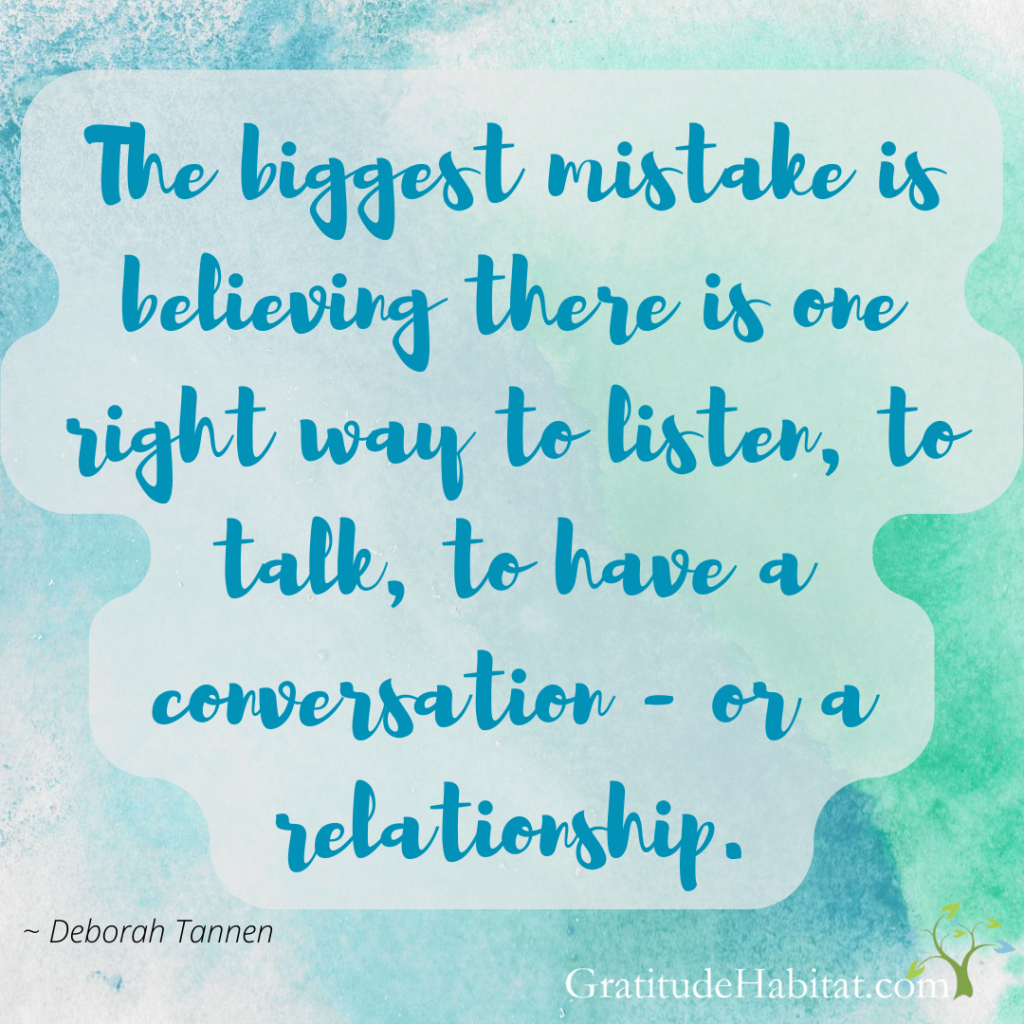Living In Gratitude: How We Converse-It’s More Than Meets the Ear
Have you ever been in a conversation with someone, and it was so easy and fun? When it was over, you walked away thinking, “Wow! What a great conversation!” How about exchanges that feel awkward, or maybe you felt misunderstood and frustrated?
Communication is an essential part of life. We communicate with family, friends, strangers, coworkers, and so many others.
We share information, solve problems, agree on a course of action, and socialize through communication.
Yet so often, because of different styles of communicating, our meaning and intention may be lost or misinterpreted by others, leading to misunderstandings and, at times, conflict.
American author and professor of linguistics at Georgetown University, Deborah Tannen, writes about these style differences. We all have different ways we communicate that are forged from our culture, gender, socialization, and geography, to name a few of our conversational influences.
Conversational styles are personal and unpredictable, states Tannen, but typically men and women have different ways of achieving outcomes when it comes to communicating.
Women more often engage in more collaborative conversational styles. There is a give and take when speaking and listening, with participants building off one another’s ideas. It’s inclusive and supportive, focusing on connection and compromise rather than conflict.
Men more frequently employ a competitive conversational model. The desired outcome is to be seen as an expert or authority, stressing individuality and claiming power and status. There are more monologues than back and forth dialogue in this style.
These styles are socially ingrained at a young age. Girls frequently interact and play in small groups or one-on-one. Activities are typically structured and non-competitive. The desire is to create and maintain close relationships. Young boys more often play in larger groups where activities are more competitive. These hierarchical interactions teach boys to assert their position and attract an audience rather than forge individual close friendships.
These skills continue into adulthood. Women tend to ask more questions, take turns talking and listening, provide support and agreement through backchanneling, such as nodding or offering uh-huhs. Gentle and polite, females focus on community and cooperation, preferring to resolve issues through compromise than confrontation. Rapport, connections, and closeness are all negotiated and achieved through this collaborative conversational style.
Adult males often engage in more forceful, to-the-point, and authoritative conversations. This learned conversation style aims to avoid failure, preserve independence, negotiate and maintain status, and rise to control the conversation. The comments of others may be disregarded, and males tend to use little to no backchanneling.
Tannen states that neither is right or wrong; they are simply different.
Tannen describes how conversations can go wrong on a Hidden Brain podcast episode, Why Conversations Go Wrong.
She discusses how people have differing ideas about how long a pause should be before jumping in to speak. For some people, like herself, pauses in speech only need to be relatively short before being a green light for others to pick up the conversation. Other people require longer speech gaps, or they feel as though they’ve been interrupted.
Tannen also points to how someone with a collaborative style often gets interrupted or shut down when speaking with an individual with a more competitive manner of speaking.
People typically have either rapport or reporting conversational styles. Individuals, frequently women, with a rapport style may ask a question rather than make a statement.
For example, if you need to decide on a place to eat lunch, someone with a rapport style may ask, “What do you feel like for lunch today?” while an individual with a reporting style would state, “Let’s go to that pizza place for lunch.”
Those with rapport styles start by offering a general question to gauge the temperature of what others want. People who default to a reporting style prefer to be transparent with their communication.

But, even this can go awry if you have two people with two different styles. If the rapport person asks, “Where shall we go to lunch?” and the reporting person replies, “Let’s go to the pizza place,” the first person may feel like what they hoped would be a conversation. They were most likely hoping their question would spark a conversation that arrives at a mutually agreed-upon restaurant. At the same time, the person who wants pizza interpreted the question as needing a specific answer.
Even intention can be misconstrued. For example, when a mother suggests her daughter wear something different, the mother’s intent is most likely to protect her daughter: Through experience, she understands that women are judged on their appearance. Of course, the mom wants to help her daughter avoid any public discomfort based on her clothing. But her daughter detects a very different message – one of disapproval.
Realizing that there are many ingrained reasons we each develop unique communication styles can help us take a step back and realize that not everyone has the same manner of speaking and listening. Every gender, every person, every nationality has distinct communication customs and styles. It pays to take that into account to avoid frustration and misinterpretation.
When engaging in conversation, it’s helpful to understand our style and attempt to glean insights into the techniques of others. Especially for mixed-gender interactions, it may mean working to adapt to the styles of those around you. If you get interrupted, speak up and inform the person you will finish your train of thought. If you are an interrupter, strive to actively listen rather than forming your next reply.
Communication isn’t easy, but it is necessary. Read Deborah Tannen’s books or listen to the podcast episode to learn more about communication styles and communicative competence.
May your day be filled with gratitude and great conversations.









